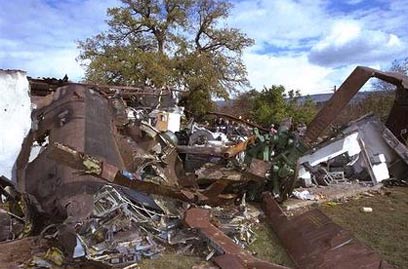

A helicopter disaster took the lives of 73 soldiers and officers 10 years ago, and according to a senior officer in the Israel Air Force, "even today it would be impossible to completely prevent a big disaster in the skies. After the helicopter disaster the Air Force underwent a makeover…Despite all this, one must remember that there are always human errors, and in this field, any mistake is fatal."
On the tenth anniversary of the tragedy, in the IAF it is still difficult to talk about that night where two Sikorsky CH 53 helicopters crashed over Kibbutz Shaar Yashuv in northern Israel on February 4, 1997.

Remains of one of the helicopters (Photo: Avi Ohion)
The officer explained the importance of safety in the Air Force: "There is nothing more important than taking meticulous safety precautions; this is instilled in the air crew men from the very first moment of the flight training, and in preparation for every flight."
On that day of the crash, he said, "it seemed that our worst nightmare had come true. Not only an accident, but one that led to the death of so many soldiers."
Following the disaster, the Air Force began implementing important lessons learned, and, in this context, installed of one of the world's most sophisticated simulators on an IAF base about a year ago.
The simulator, costing some USD 40 million, replicates extreme flying conditions, and allows helicopter pilots to develop the skills to cope with them, in a risk-free environment.
"A pilot is not allowed to fly unless he has accumulated enough hours on the simulator. This significantly contributes to the learning of safety measures," the Air Force explained. "There is no helicopter pilot that doesn't use the simulator once every few weeks."
9 years later, another crash
Just when the IAF thought these new steps were doing their part and could even overcome human error, the second Lebanon war broke out, and on July 20 two Apache helicopters crashed in northern Israel.
A pilot was killed and three of his comrades were injured in the incident. "The collision between helicopters is almost always caused by human error," explained a senior IAF source. "This was also the cause of this incident, we believe."
The IAF has attempted to distinguish between 1997's helicopter disaster and last summer's crash. "During combat other things occur, situations that don’t resemble training, the risk is immeasurably greater."
The senior IAF source mentioned the great number of flights, over one thousand, which were made by helicopters during the war to show how intense the situation in the sky was.
The IAF refused to comment on other helicopter-related incidents that occured during the war, saying, "it is wrong to consider incidents that were caused by technical failures and hits from enemy fire in the same category."
Committee calls crash a 'mystery'
The committee that investigated the disaster ten years ago concluded that the final moments leading up to the crash were a "mystery." This led to a great wave of criticism from bereaved parents.
The committee's conclusions regarding a few junior officers enhanced anger amongst bereaved families, who claimed that the Air Force's top brass was also to blame.
The parents claimed that the deficient procedures and the presence of many explosives in the helicopters left no chance for the soldiers to be saved after the crash.
Even today, the IAF refuses to respond to these claims. "The families' grief is understandable, and is the grief of the whole Air Force, the IDF, and the State of Israel," said the senior officer. "The committee that was appointed by the defense minister did its job and these were its conclusions and findings."















